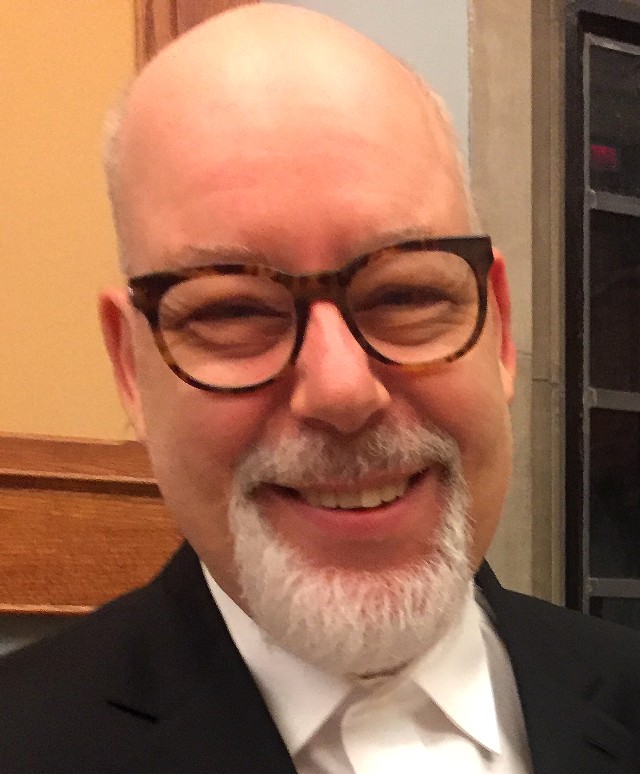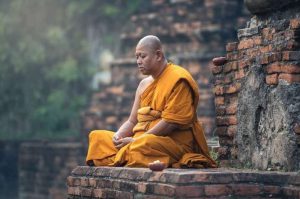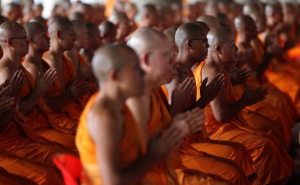
One Earth Sangha is 10 years old this year. You may be forgiven for wondering who they are, since Green Buddhism is still an outlier within mainstream Buddhist communities and virtually absent from the perspectives of secular environmental activist groups.
Here’s how One Earth Sangha describe their work:
The mission of One Earth Sangha is to support humanity in a transformative response to ecological crises based on the insights and practices of the Buddhist tradition. Through our Virtual EcoDharma Center, we are here to inspire, inform, and guide our members in actions that will end ecological violence. This is our contribution to Wise Action.
(One Earth Sangha)
One Earth Sangha is the home of eight-session EcoSattva training programs, one-day EcoDharma Explorations, and a variety of other initiatives designed to nurture impact networks in two complementary ways: bringing Buddhist community leaders and practitioners together to support each other in bringing Green Buddhist perspectives and actions to their sanghas; and introducing secular and interfaith environmental activists to a Green Buddhist perspective. Many EcoSattva training graduates from the latter group are professionals in managerial positions in large organizations for whom environmental awareness and action are integral to their mission statements.
One might say One Earth Sangha strives to bring action to the peaceful and peacefulness to the activists. In fact, One Earth Sangha is developing a curriculum more specifically focused on leadership training and organizational development resources for those audiences, as one of their goals for the next decade.
In our recent conversation, Kristin Barker, co-founder and director of One Earth Sangha, gave me a quick view of the koan we are facing. We see the multifaceted negative impacts of the Anthropocene, including many forms of ecological and societal breakdown—a polycrisis. We see how incredibly complex the problem is, and how complex addressing the problem is. And we see how people’s predominant response has been to turn away in denial, distraction, and despair.
Building the Green Buddhist impact network
The goal of One Earth Sangha’s work is to support people in turning toward and being with our Anthropocene realities, and finding community in what is often a lonely quest for positive engagement. That loneliness is a major stumbling block. So is the complexity of the many types of ecological healing we need. Bodhisattvas who focus on environmental action, eco-sattvas, from whatever lineage or tradition that speaks to them on a personal level, are greatly strengthened by connecting with other like-minded individuals.
When asked about feedback from EcoSattva training participants, Kristin said that while folks were deeply grateful for the teaching and the training, the part they say gave them the biggest boost was the group interaction.
I wondered what type of analytics One Earth Sangha was able to glean from a longitudinal study of their graduates’ subsequent activities. Alas, encouraging people to answer surveys and give that type of feedback has been difficult. But those who keep coming back for the training, bringing new people with them, are themselves proof of concept.

The ideal scenario would be for training graduates to return to their local communities to coordinate hyper-local projects, working with other graduates. The challenge has been that those projects can play out in radically different contexts, from cleaning up waterways, to greening the power grid, to food security, to decolonizing global trade. . . . Consequently, while participants benefit greatly from mutual support, that doesn’t necessarily result in working together on shared projects. For graduates, their diverse backgrounds and professional commitments mean they would likely not cross paths with fellow participants in their day-to-day work.
With that in mind, another goal for One Earth Sangha’s coming decade will be to build out their online platform with an agora where leaders and facilitators can find enhanced networking and mentorship capabilities. It seems the hardest part of being a Green Buddhist is being the lonely only. Presenting the realities of the Anthropocene is difficult in Dharma centers. People feel that they are already struggling with the hardships of daily life, and can’t bring themselves to face the suffering that is climate and biodiversity collapse, and so on. It’s not the type of suffering that is easy to turn toward and stay with. But we must. Indeed, some of the teachers in the EcoSattva training sessions specifically address the issue, pointing out that this moment is an incredibly powerful opportunity for us to deepen our practice, one not to be missed.
Green Buddhist practice and new tools for the work that reconnects
Many environmentally engaged professionals are demoralized. We’re just documenting our decline, they say, but not actually doing anything to redirect our actions. Sitting with a Buddhist perspective of interdependence, impermanence, and no-self gives them a new paradigm for a response that engages heart and mind for positive change. It revitalizes them and frees them from the paralysis of facing our polycrisis with only the tools that created it. Sometimes in Zen practice we talk about enlightenment as a turning about in the heart-mind. It’s so subtle—just a change of perspective—and yet so difficult to discover.
However, attachment to ossified understandings of that message from earlier historical eras and different cultures can leave us blind to the shared duhkha of our present institutions, social systems, and livelihoods.

Admittedly, One Earth Sangha’s main audience is among North American convert Buddhists. But they are not alone. Looking at the tremendous efforts and accomplishments of the International Network of Engaged Buddhism (INEB)’s work in Asia, the EcoTemple networks of Japan, the fantastic work of Buddhist Humanists in Taiwan, and other initiatives, North America has yet to find the same degree of cohesive action. The future has already arrived but it’s unequally distributed. It would be great if there were greater collaboration between these various Pure Lands!
The challenge is not simply lack of communication between far-flung communities. As the One Earth Sangha website acknowledges:
We also aspire to skillfully challenge contemporary convert-Dharma culture and practices. We suggest that because the predominant Dharma traditions in the West are embedded in consumerist, militarist, hyperindividualist, white supremacist, and species-ist culture, they will have a tendency to replicate and empower these cultural patterns.
(One Earth Sangha)
In other words, as profoundly meaningful and beneficial as the Buddhadharma is, Buddhist teachers and community leaders still need to meet their sanghas in the place of suffering. We are all human beings and we are all aware of what’s happening to our planet and civilizations. Buddhist teachers are people first. They feel the same eco-anxiety as everyone else. It can be overwhelming. They may not have the words to articulate a practice that addresses this form of duhkha.
As Asa Hershoff recently noted in his column for BDG, The Five Wisdoms, on addressing our Anthropocene crises:
[It] is painfully clear [we have a] failure of remedies. The institutions, laws, rules and structures of society have failed. Philosophy, religion, and especially modern psychology has failed and failed badly. This has all happened on their watch.*
Taking that fork in the road
EcoSattva training involves eight sessions on a journey beyond recognition of the interdependence, cause-and-effect, and implications of our predicament, to a new set of concepts derived from the Buddhadharma. This scaffolding for our future culminates in the eighth session with understanding and taking EcoSattva Vows.
Core teachings for each session comprise extended videos by teachers including Kristin Barker, Damchö Diana Finnegan, Dr. Britt Wray, Dr. Larry Ward, Dr. Michael Yellow Bird, Dr. Peggy Rowe Ward, Lama Willa Blythe Baker, Dr. Adam Lobel, Kritee Kanko, Tim Ream, Mark Coleman, and Rev. Myokei Caine-Barrett.
The sessions are titled:
1. Arriving and Setting a Course
2. Preparing for the Journey
3. Meeting just this Heart
4. Reckoning with Entangled Structures
5. Making a Home in Uncertainty
6. Creating and Discovering the Way
7. Expressing Our Awakened Agency
8. Affirming and Resolving
Each comprises opening Living Earth Acknowledgments and prayers, one or more core teaching videos, guided meditation videos, inquiries and group practices for discussion, supplemental resources, and dedication of merit.
One Earth Sangha also holds monthly live events for participants in, and graduates of, their training programs. As Kristin noted in our conversation, the benefits of this practice are greatly enhanced by community involvement—being and acting with others.
In a way, the session videos reminded me of lojong practice: a series of spoken truths that will resonate long after the experience of hearing them, and that will both ground and guide future action. These are pan-Buddhist teachings that speak to our shared journey, regardless of tradition or lineage. However, while they provide a unified alternative narrative dedicated to Coming back to Life, or the Work that Reconnects, as taught by Joanna Macy and Molly Bloom, the specificity of one’s work after one decides to walk the path of an EcoSattva is not contained within the course material. That, of course, is up to you.
Please share your Green Buddhist journey with us all. Don’t hide your light under a rock. You, your voice, your actions, are needed now more than ever. Bowing.
* Confronting the Five Horsemen of the Current Apocalypse (BDG)
See more
Related features from BDG
Crystal Mountain and the Wheel of Protection
How Buddhists Can Embrace the Degrowth Movement
Buddhist Voices in the Climate Crisis: Welcome to the Anthropocene
Buddhistdoor View: A New Relationship with Nature
Does It Make Any Difference?
The Earth Holder Community, Branching Out
Touching the Earth: An Ecodharma Retreat
Related news reports from BDG
Theravada Buddhists Celebrate the Beginning of Rains Retreat
Buddhists Discuss Self-Immolation and Protest after Climate Activist’s Death
Buddhist Teacher David Loy Briefly Detained in Denver During Climate Protests












